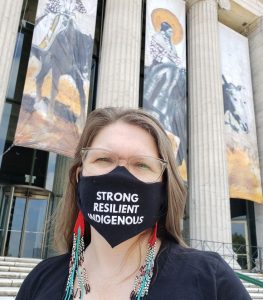In 1977, the United Nations International Conference on Discrimination against Indigenous Populations in the Americas asked to replace Columbus Day with Indigenous Peoples' Day. In 1990, South Dakota became the first state to do so and in 1992, Berkeley, Calif., the first city. Since then, more states and cities have followed.
Indigenous People in Chicago
Although Illinois and Chicago have yet to do so, this year Chicago Public Schools is celebrating Indigenous Peoples' Day rather than Columbus Day on October 12 thanks to the work and activism of local youth organizations Chi-Nations Youth Council,, opens a new window International Indigenous Youth Council, opens a new window and Semillas y Raices, opens a new window.
Land acknowledgement in partnership with the American Indian Center:
The Chicago Public Library is located on the traditional homelands of the Council of the Three Fires: the Ojibwe, Odawa, and Potawatomi Nations. Many other tribes such as the Miami, Ho-Chunk, Menominee, Sac, and Fox also called this area home. The region has long been a center for Indigenous people to gather, trade, and maintain kinship ties. Today, one of the largest urban American Indian communities in the United States resides in Chicago. Members of this community continue to contribute to the life of this city and to celebrate their heritage, practice traditions, and care for the land and waterways.
Books
Learn more about the experiences of Indigenous peoples in these books.
An Indigenous Peoples' History of the United States: There are over 500 federally recognized Native American tribes in the United States today. In this book, historian and activist Roxanne Dunbar-Ortiz tells the country's history from the perspective of its Indigenous peoples.
Unworthy Republic: In 1830, the U.S. government forced the removal of Native Americans to territories west of the Mississippi River. Although said to be a humanitarian mission, thousands of Native Americans lost their possessions, lands and lives over the next decade.
Spirit Run: In his debut memoir, the son of Mexican immigrants decides to join Indigenous and Native American runners in a trek from Alaska to Guatemala.
Carry: A Memoir of Survival on Stolen Land: In this powerful memoir and meditation on gun violence, Toni Jensen explores what it means to exist in today's world as an Indigenous woman.
The Heartbeat of Wounded Knee: Native America from 1890 to the Present: Anthropologist David Treuer is Ojibwe and grew up on a reservation in Minnesota. His book chronicles how Native America didn't disappear after the events of Wounded Knee, but through their intense struggle to preserve their languages, traditions and very existence, they have shown that they live lives full of resilience, strength and unprecedented reinvention.



Add a comment to: Indigenous Peoples’ Day: Learn More in Recent History, Memoir